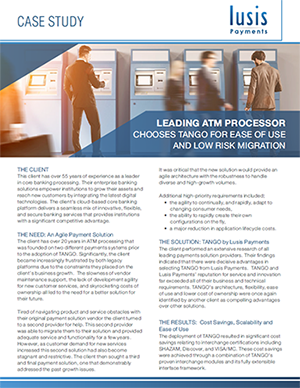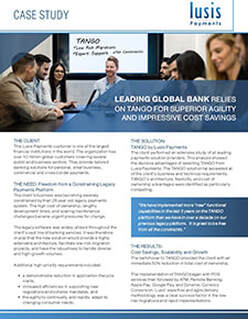LUSIS USER PROFILES
Leading ATM processor chooses TANGO for ease of use and low risk migration
THE CLIENT
This client has over 55 years of experience as a leader in core banking processing. Their enterprise banking solutions empower institutions to grow their assets and reach new customers by integrating the latest digital technologies. The client's cloud-based core banking platform delivers a seamless mix of innovative, flexible, and secure banking services that provides institutions with a significant competitive advantage.
THE NEED: An Agile Payment Solution
The client has over 20 years in ATM processing that was founded on two different payments systems prior to the adoption of TANGO. Significantly, the client became increasingly frustrated by both legacy platforms due to the constraints they placed on the client’s business growth. The slowness of vendor maintenance support, the lack of development agility for new customer services, and skyrocketing costs of ownership all led to the need for a better solution for their future.
Tired of navigating product and service obstacles with their original payment solution vendor the client turned to a second provider for help. This second provider was able to migrate them to their solution and provided adequate service and functionality for a few years. However, as customer demand for new services increased this second solution had also become stagnant and restrictive. The client then sought a third and final payment solution, one that demonstrably addressed the past growth issues.
It was critical that the new solution would provide an agile architecture with the robustness to handle diverse and high-growth volumes.
Additional high-priority requirements included;
This client has over 55 years of experience as a leader in core banking processing. Their enterprise banking solutions empower institutions to grow their assets and reach new customers by integrating the latest digital technologies. The client's cloud-based core banking platform delivers a seamless mix of innovative, flexible, and secure banking services that provides institutions with a significant competitive advantage.
THE NEED: An Agile Payment Solution
The client has over 20 years in ATM processing that was founded on two different payments systems prior to the adoption of TANGO. Significantly, the client became increasingly frustrated by both legacy platforms due to the constraints they placed on the client’s business growth. The slowness of vendor maintenance support, the lack of development agility for new customer services, and skyrocketing costs of ownership all led to the need for a better solution for their future.
Tired of navigating product and service obstacles with their original payment solution vendor the client turned to a second provider for help. This second provider was able to migrate them to their solution and provided adequate service and functionality for a few years. However, as customer demand for new services increased this second solution had also become stagnant and restrictive. The client then sought a third and final payment solution, one that demonstrably addressed the past growth issues.
It was critical that the new solution would provide an agile architecture with the robustness to handle diverse and high-growth volumes.
Additional high-priority requirements included;
- the agility to continually, and rapidly, adapt to changing consumer needs,
- the ability to rapidly create their own configurations on the fly,
- a major reduction in application lifecycle costs.
|
THE SOLUTION: TANGO by Lusis Payments
The client performed an extensive research of all leading payments solution providers. Their findings indicated that there were decisive advantages in selecting TANGO from Lusis Payments. TANGO and Lusis Payments’ reputation for service and innovation far exceeded all of their business and technical requirements. TANGO's architecture, flexibility, ease of use and lower cost of ownership were once again identified by another client as compelling advantages over other solutions. THE RESULTS: Cost Savings, Scalability and Ease of Use
The deployment of TANGO resulted in significant cost savings relating to interchange certifications including SHAZAM, Discover, and VISA/MC. These cost savings were achieved through a combination of TANGO's proven interchange modules and its fully extensible interface framework. Migrating their ATMs onto TANGO also resulted in significant cost of ownership reductions due to TANGO's licencing policy. The client's previous legacy system included additional fees based on the transaction volumes processed. However, with TANGO, the client can increase their transaction volumes without additional cost. The professional management of the ATM migration onto TANGO also gave the client great confidence in Lusis Payments as a reliable vendor. Consequently they are now looking to expand their system with the TANGO AI Fraud solution. |
Leading Global Bank relies on TANGO for superior agility & impressive cost savings
THE CLIENT
This Lusis Payments customer is one of the largest financial institutions in the world. The organization has over 10 million global customers covering several public and business sectors. They provide tailored banking solutions for personal, small business, commercial and cross border payments.
THE NEED: Freedom from a Constraining Legacy Payments Platform
The client's business was becoming severely constrained by their 28 year-old legacy payments system. The high cost of ownership, lengthy
development times, and soaring maintenance challenges became urgent pressures for change. The legacy software was widely utilized throughout the client's vast line of banking services. It was therefore crucial that the new solution would provide a highly extensible architecture, facilitate low-risk migration projects, and have the robustness to handle diverse and high-growth volumes.
This Lusis Payments customer is one of the largest financial institutions in the world. The organization has over 10 million global customers covering several public and business sectors. They provide tailored banking solutions for personal, small business, commercial and cross border payments.
THE NEED: Freedom from a Constraining Legacy Payments Platform
The client's business was becoming severely constrained by their 28 year-old legacy payments system. The high cost of ownership, lengthy
development times, and soaring maintenance challenges became urgent pressures for change. The legacy software was widely utilized throughout the client's vast line of banking services. It was therefore crucial that the new solution would provide a highly extensible architecture, facilitate low-risk migration projects, and have the robustness to handle diverse and high-growth volumes.
|
Additional high-priority requirements included;
|
“We have implemented more “new” functional capabilities in the last 3 years on the TANGO platform than we have in over a decade on our previous legacy platform. It is great to be free from all the constraints.” |
|
THE SOLUTION: TANGO by Lusis Payments
The client performed an extensive study of all leading payments solution providers. This analysis showed the decisive advantages of selecting TANGO from Lusis Payments. The TANGO solution far exceeded all of the client's business and technical requirements. TANGO's architecture, flexibility, and cost of ownership advantages were identified as particularly compelling.
THE RESULTS: Cost Savings, Scalability and Growth The switchover to TANGO provided the client with an immediate 50% reduction in total cost of ownership. The implementation of TANGO began with POS services then followed by ATM, Remote Banking, Apple Pay, Google Pay, and Dynamic Currency Conversion. Lusis' expertise and agile delivery methodology was a clear success factor in the low risk migrations and rapid implementations. |
Established in 1972, BankservAfrica’s primary objective is to function as a clearing house for the South African banking and financial sectors.
Established in 1972, BankservAfrica’s primary objective is to function as a clearing house for the South African banking and financial sectors.
Owned by South Africa’s four large-volume banks and a consortium of smaller-volume banks, BankservAfrica’s offerings include both real-time card-based services and traditional services such as direct debits, credit transfers and utility-type services. BankservAfrica processes approximately 3 billion transactions inclusive of batched and real time, valued at between ZAR 7 to 8 trillion.
|
|
“We have a team that’s worked very closely with Lusis Payments, and BankservAfrica has had control over the source, up to a certain degree, and the flexibility of adding new functionality without getting the supplier involved every time we want to do something. For us, that’s been one of the big advantages,” Nolte said. “The other big benefit is the licensing model. Whereas with other platforms you license the transaction process, with Lusis Payments you license the software and you can process as many transactions as you want to. That model really works for us.” |
Challenge: The Need for a Scalable Product
For an organization like BankservAfrica, which wants to expand into the rapidly growing Southern African Development Community, the need for a fully functional core system that can cope with fast-changing payment methods and customer requirements is mission-critical. The decision by BankservAfrica’s current payments system supplier to sunset its product provided the perfect opportunity for the organization to conduct a thorough review of a replacement system and alternatives, while reassessing how the payments platform could become a genuine enabler of BankservAfrica’s business vision. It was critical for BankservAfrica that the solution selected ensure that it could quickly react to customers’ requirements while allowing the organization to add innovative payment solutions.
The Solution: Lusis Payments and TANGO
Ultimately BankservAfrica chose Lusis Payments based on the capability of TANGO. The solution met the organization’s business requirements, which included that it must be a configurable product with specific monitoring capabilities. In addition, BankservAfrica liked TANGO’s cost and clear licensing structure. BankservAfrica’s board approved the rollout of TANGO into production. The implementation of TANGO was conducted in a phased approach.
Real-time clearing (RTC) was rolled out first, as it involved a smaller amount of banks and volumes. ATM was next to be migrated by BankservAfrica, as this forms a large part of its business, and the majority of South Africa’s banks are participating. ATM was successfully migrated after successful certification testing with all participants. “Our credit card authorization system followed and was implemented in February 2013,” Nolte said. “The last component was debit card, which was fully migrated.”
The Results: Operational Flexibility Brings Benefits
The initial results of the switchover to TANGO have clearly proven BankservAfrica correct in opting for Lusis Payments, with an increase in ATM volumes recorded early in the implementation. But the main benefit of TANGO for BankservAfrica is its operational flexibility. According to Nolte, “TANGO is a lot more configurable and is parameter-driven. From a flexibility and maintainability perspective it’s also a lot easier, and that is a big benefit for us.”
Another key benefit of TANGO is that it is essentially “future-proof,” with the ability to seamlessly integrate new services and functionality as and when required.




